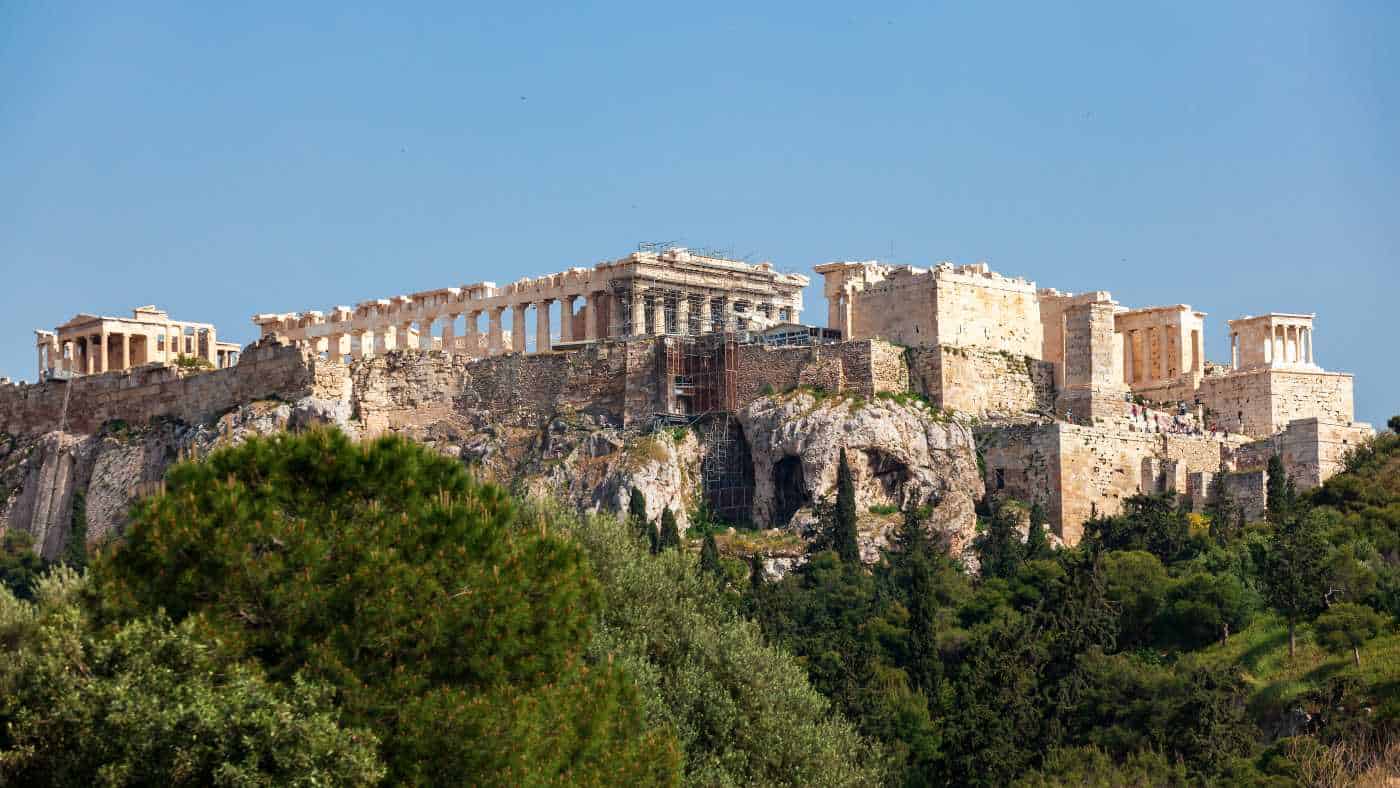Ancient Greek temples have long been the epitome of architectural brilliance and cultural significance. These magnificent structures have stood the test of time, offering us a glimpse into the fascinating world of ancient Greece. But what secrets do they hold? Join us as we embark on a journey through time, exploring the wonders of ancient Greek temples, their architectural marvels, and the pivotal roles they played in the lives of the people who built them.
Short Summary
- Explore the iconic Parthenon in Athens, Temple of Hera in Olympia, and majestic Temple of Poseidon at Sounion.
- Discover lesser known temples such as the Erechtheum on Acropolis and Valley of Temples in Agrigento.
- Learn about ancient Greek temple architecture styles & innovations, plus their role in Ancient Society.
Discovering the Parthenon: Athens’ Iconic Temple
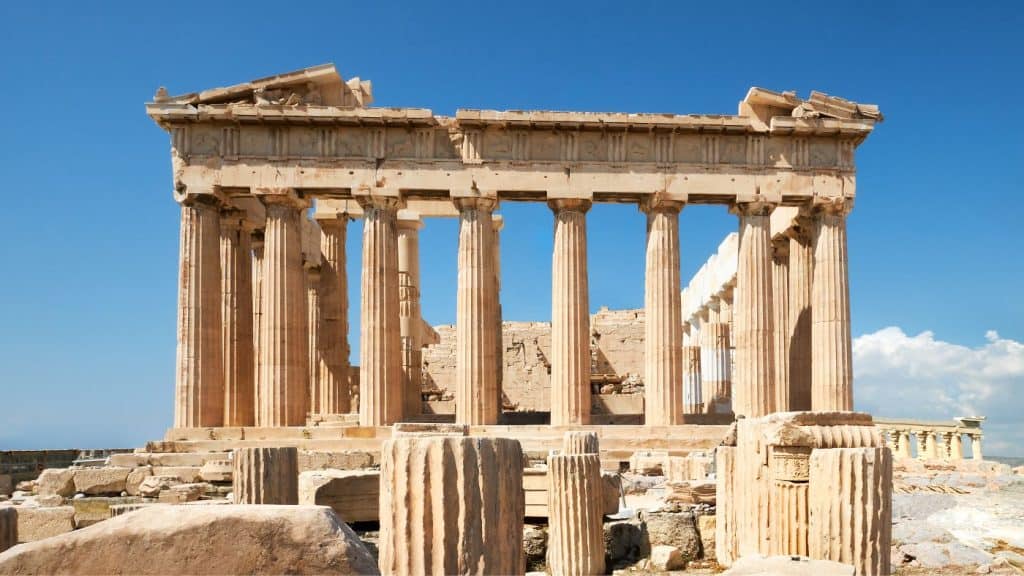
The Parthenon, an ancient Greek temple dedicated to the goddess Athena, stands as a testament to the architectural prowess of the ancient Greeks. Built in the 5th century BCE, this double peripteral Doric temple represents the pinnacle of Classical Greek architecture and has served various purposes throughout history, including:
- a temple
- a fortress
- a church
- a mosque
- a powder magazine
Designed by architects Ictinus and Callicrates, the Parthenon was constructed during the Golden Age of Athens, when the city was at the height of its power. This iconic temple, situated on the Acropolis, commemorates the Hellenic victory over the Persian invaders and showcases the beauty of ancient Greek architecture. The Parthenon’s decorative sculptures and pediments illustrate the rich mythological heritage of ancient Greece, while the temple’s unique architectural features, such as its Doric columns, reflect the innovation and creativity of its builders.
Over the centuries, the Parthenon has witnessed countless historical events and changes. In 1687, during the conflict between the Ottoman Empire and the Venetians, the temple suffered significant damage when it was used as a powder magazine. Despite this, the Parthenon remains one of the best-preserved ancient Greek temples. However, the statue of Athena Parthenos, once housed within the temple, was looted by one of the Roman emperors and eventually destroyed.
Today, the Parthenon continues to captivate visitors from around the world, embodying the essence of ancient Greek culture and serving as a symbol of the remarkable achievements of the ancient world. As we delve deeper into the fascinating world of ancient Greek temples, let us keep in mind the Parthenon’s significance and the enduring legacy of the architectural wonders it represents.
Temple of Hera: A Sacred Site in Olympia

The Temple of Hera, situated in Olympia, is an archaic Greek temple dedicated to the highest goddess in the Greek pantheon. Built around 590 BC, this ancient temple was later destroyed by an earthquake in the 4th century AD, leaving behind a fascinating archaeological site for us to explore.
One of the unique features of the Temple of Hera is its altar, oriented east-west, which stands in contrast to the more common north-south orientation of other Greek temples. This sacred site once housed votive offerings and served as a religious center for the ancient Greeks, reflecting their devotion to the goddess Hera.
Another temple believed to be dedicated to Hera is the Temple E in Selinunte, renowned for providing excellent photographic opportunities. Both temples serve as important sacred sites, offering valuable insights into the religious practices and beliefs of the ancient Greeks.
The Majestic Temple of Poseidon at Sounion

Perched on a sea-girt promontory, the Temple of Poseidon at Sounion is a breathtaking example of Doric architecture, built in 440 BC. This ancient Greek temple, dedicated to the god of the sea, showcases the structural features of the Doric order, including peripteral construction and fluted columns.
The Temple of Poseidon offers:
- An architectural marvel
- Unforgettable experience for visitors
- Stunning sunset views during summer evenings
- Festive atmosphere that adds to the charm of the site
Exploring the Temple of Poseidon at Sounion allows us to appreciate the beauty and intricacy of ancient Greek temple architecture, while also immersing ourselves in the awe-inspiring natural surroundings that have been part of its allure for thousands of years.
Journey to the Temple of Apollo Epicurius at Bassae
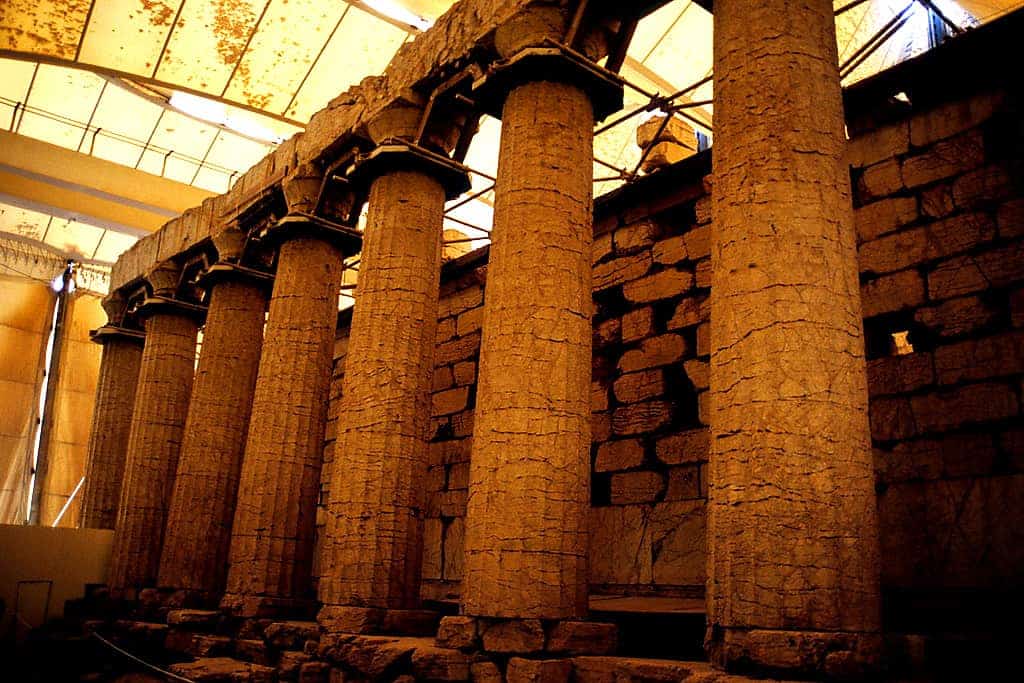
Nestled in the remote mountains of Arcadia, the Temple of Apollo Epicurius at Bassae stands as a testament to the bold and innovative architectural designs of ancient Greece. This well-preserved temple, believed to have been constructed between 450 and 400 BC, features elements from all three classical orders: Doric, Ionic, and Corinthian.
The Temple of Apollo Epicurius, a peripteral temple, is believed to have been designed by the architect Ictinus, who was also responsible for the Parthenon. One of the most remarkable aspects of this temple is its north-south alignment, which sets it apart from the majority of Greek temples that are typically aligned east-west.
Unfortunately, the temple’s decorative frieze of sculptured panels was removed in 1812 and is now on display at the British Museum. Despite this, the Temple of Apollo Epicurius, an archaic temple, remains a stunning example of ancient Greek architecture, offering visitors a unique glimpse into the creative spirit of its builders.
The Enigmatic Erechtheum: Architectural Marvel on the Acropolis
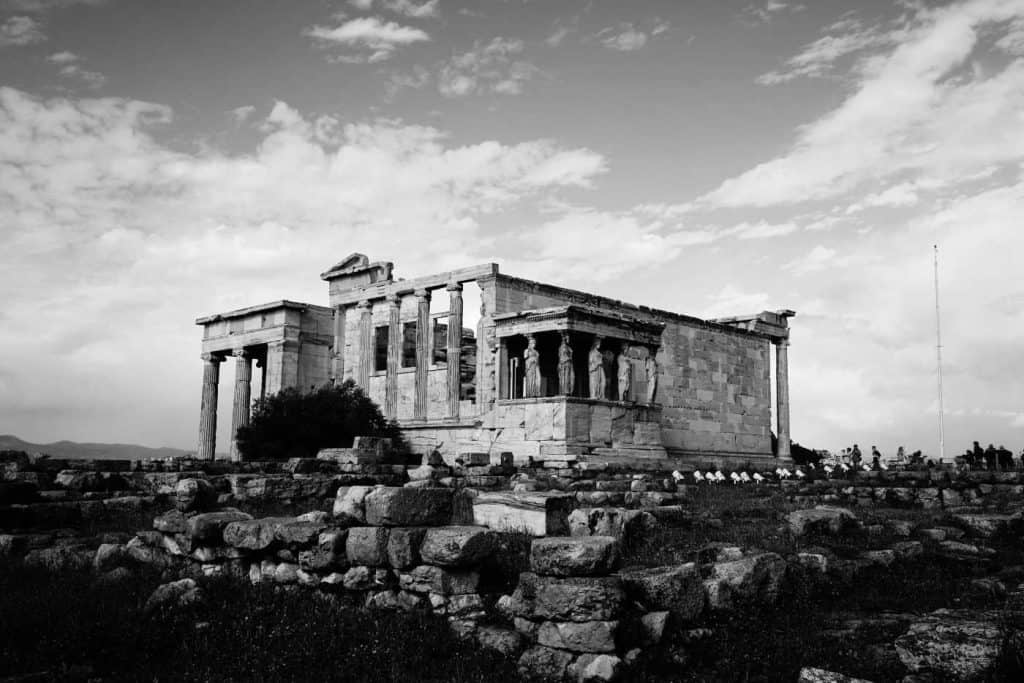
The Erechtheum, an ancient Greek temple located on the northern side of the Acropolis of Athens, is known for its unique architectural features and its dedication to both Athena Polias and Erechtheus.
One of its most striking elements is the Porch of the Karyatides, a pi-shaped structure supported by six female figures instead of columns, creating an impressive visual impact. Constructed entirely from Pentelic marble, the Erechtheum showcases the skill and artistry of ancient Greek craftsmen. The temple’s intricate design and dedication to two significant deities reflect the complexity and richness of ancient Athenian culture and religious beliefs.
As we continue to explore the fascinating world of ancient Greek temples, the enigmatic Erechtheum serves as a reminder of the unique architectural innovations and cultural significance that these structures embody.
Doric Masterpiece: The Temple of Segesta in Sicily
Situated in the northwestern part of Sicily, the Temple of Segesta is a remarkably well-preserved doric temple built in the late 5th century BC. This architectural masterpiece offers picturesque views of the Mediterranean, Sicilian vegetation, and rolling hills, making it a must-visit destination for anyone interested in ancient Greek architecture and history.
The Temple of Segesta is believed to have never been completed, with indications suggesting that construction was ultimately abandoned. Despite this, the temple remains an impressive example of Doric architecture, featuring 614 Doric columns that create a striking visual effect.
Visiting the Temple of Segesta offers:
- An opportunity to admire its architectural brilliance
- A chance to enjoy the breathtaking vistas that surround it
- A unique and unforgettable experience for all who venture to this ancient site.
Paestum: Italy’s Ancient Greek Treasure
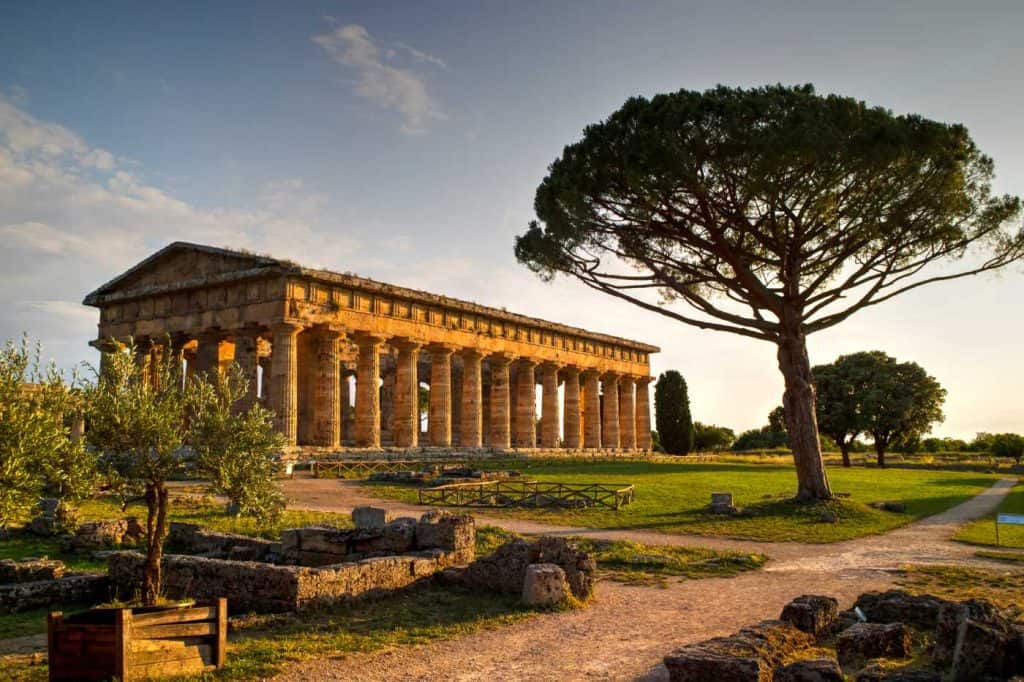
Paestum, an ancient city in southern Italy, is home to three remarkably well-preserved Greek temples, offering a fascinating glimpse into the architectural mastery of ancient Greece. These temples include the Temple of Hera, the Temple of Athena, and another temple dedicated to Hera, each showcasing the beauty and intricacy of Doric architecture.
The Temple of Hera, one of the earliest Doric temples, was constructed in the 6th century BC and remains an important sacred site for the ancient Greeks. This earlier temple, the Temple of Athena, was built in the 5th century BC and showcases the evolution of Doric architecture over time.
Paestum’s third temple, also dedicated to Hera, is another stunning example of ancient Greek temple architecture. Like the other two temples, it features Doric columns and intricate decorative elements that speak to the skill and artistry of the ancient Greeks who built it.
Visiting Paestum is a delightful experience, with well-preserved temples offering magnificent vistas and the nearby beach providing an idyllic setting for relaxation. The ancient city walls and other archaeological sites are also easily accessible, making Paestum a must-visit destination for anyone seeking to explore the incredible architectural treasures of ancient Greece.
The Best-Preserved Greek Temple: Temple of Hephaestus
The Temple of Hephaestus, dedicated to the god of metalworking, is the best-preserved Greek temple, showcasing the exceptional craftsmanship and architectural mastery of the ancient Greeks.
Featuring doric architecture and marble sculptures from Paros, this temple offers a unique insight into the construction techniques and artistic vision of its creators.
Designed by Ictinus, one of the architects responsible for the Parthenon, the Temple of Hephaestus is a testament to the enduring legacy of ancient Greek architecture. Its well-preserved state is a result of its long history of multiple uses, serving various purposes throughout the centuries.
As we explore the fascinating world of ancient Greek temples, the Temple of Hephaestus stands out as a shining example of the remarkable achievements of the ancient Greeks in the field of architecture. Its exceptional preservation allows us to appreciate the beauty and intricacy of its design, serving as a reminder of the incredible skill and artistry that went into the construction of these stunning structures.
Valley of the Temples: Agrigento’s Magnificent Ruins
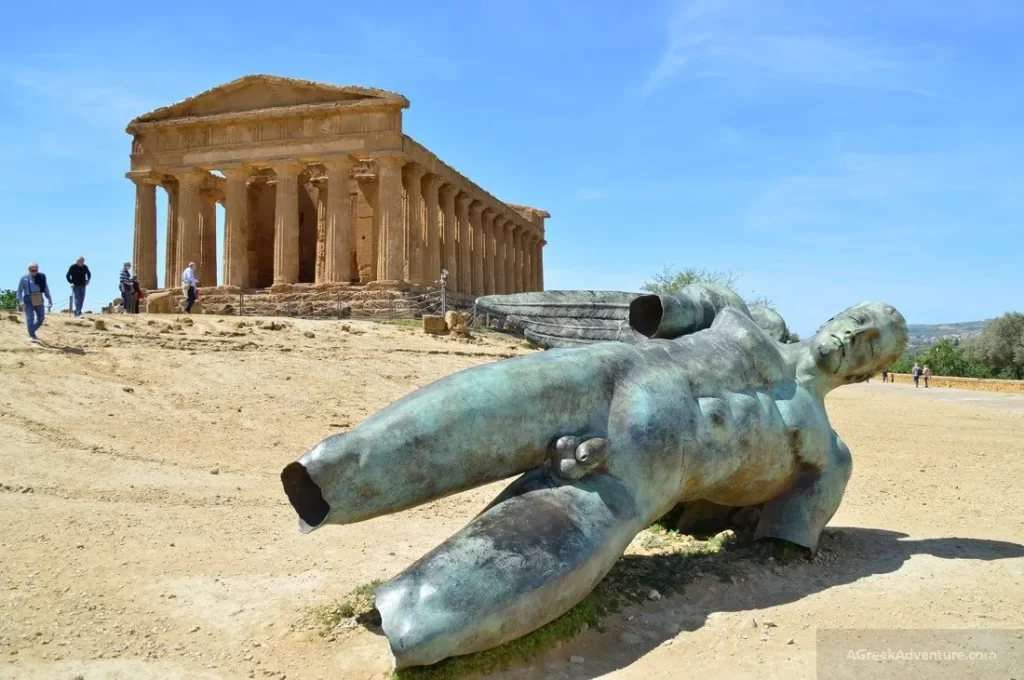
The Valley of the Temples in Agrigento, Sicily, is a treasure trove of ancient Greek architecture, boasting a collection of seven magnificent temples that offer a fascinating glimpse into the past. These temples include the stunningly preserved Temple of Concordia and the oldest Temple of Heracles, showcasing the remarkable achievements of the ancient Greeks in the realm of architecture and art. These temples, which have been awarded UNESCO World Heritage status, are a testament to the enduring legacy of ancient Greek culture and the remarkable skill of the architects and craftsmen who built them.
In addition to the Temple of Concordia and the Temple of Heracles, the Valley of the Temples also features:
- Temple of Juno
- Temple of Olympian Zeus
- Temple of Hephaistos
- Temple of Hera Lacinia
- Temple of Castor and Pollux
These best preserved Greek temples, each with their own unique history and architectural features, provide a rich tapestry of ancient Greek culture and tradition.
Visiting the Valley of the Temples in Agrigento offers an unparalleled experience for those seeking to gain a deeper understanding of ancient Greek temple architecture and the pivotal role these structures played in the lives of the people who built them. As we continue to explore the fascinating world of ancient Greek temples, let us keep in mind the breathtaking beauty and enduring significance of these remarkable architectural masterpieces.
Lesser-Known Greek Temples Worth Visiting
While the more famous Greek temples often steal the spotlight, there are many lesser-known temples that are equally worthy of attention. The Temple of Apollo at Delphi, for instance, is a mountain sanctuary and revered religious site that offers a unique insight into the ancient Greek world.
Another hidden gem is the Temple of Demeter on the Greek island of Naxos, which was constructed in the 6th century BC from the highest quality white Naxian marble. This temple, dedicated to the goddess of agriculture and fertility, showcases the exceptional craftsmanship and architectural prowess of the ancient Greeks.
The Temple of Apollo at Cumae, although in a state of disrepair, is steeped in history and myth. It is believed to be the place where Daedalus, the mythical inventor, landed after escaping from the Labyrinth with his wings, which were said to have been kept in the temple of Apollo at this site.
These lesser-known temples, along with the temples of Zeus and Artemis nearby, offer a unique perspective on ancient Greek culture and the architectural innovations that defined this remarkable civilization. As we continue our exploration of the ancient Greek world, let us remember to venture off the beaten path and uncover the hidden treasures that lie waiting to be discovered.
Ancient Greek Temple Architecture: Styles and Innovations
Ancient Greek temple architecture showcases a variety of styles and innovations that continue to captivate and inspire us today. The three classical orders of architecture – Doric, Ionic, and Corinthian – each offer unique features and aesthetics that have shaped the architectural landscape of ancient Greece and beyond. The use of various materials in the construction of ancient Greek temples, such as marble and limestone, further highlights the skill and creativity of the architects and craftsmen who built them. The sculptures from the Temple of Aphaia’s pediment, for instance, demonstrate the full Classical style, reflecting the artistic evolution of the ancient Greeks over time.
The Temple of Apollo in Corinth, a symbol of the city’s prosperity and development, offers yet another example of the architectural mastery of the ancient Greeks. This temple, like many others, served as a religious center and cultural hub, reflecting the beliefs and values of the people who built it.
As we delve deeper into the fascinating world of ancient Greek temple architecture, let us remember the remarkable achievements of the architects and craftsmen who created these awe-inspiring structures. Through their ingenuity and skill, they have left behind a legacy that continues to inspire and captivate us, offering a glimpse into the rich cultural tapestry of the ancient world.
The Role of Greek Temples in Ancient Society

Greek temples played a significant role in ancient society, serving not only as religious centers but also as cultural hubs and symbols of power and wealth. These magnificent structures reflected the beliefs and values of the people who built them, showcasing their architectural prowess and artistic vision. Ancient Greek temples were primarily built to house statues of gods. They served as a shelter for these holy figures. For example, the Temple of Olympian Zeus was a religious center, housing a cult statue of the god. Religion in ancient Greece did not require large gatherings of people within the temple to worship; instead, temples were primarily monuments to the gods, showcasing their divine presence and power.
The ruins of Greek temples can be found throughout the ancient world, from South Italy and Turkey to Greece itself, serving as enduring reminders of the incredible achievements of the architects and craftsmen who built them. These temples also offer valuable insights into the religious practices and beliefs of the ancient Greeks, shedding light on the complex relationship between religion, culture, and power in the ancient world.
As we continue to explore the fascinating world of ancient Greek temples, let us remember the pivotal roles they played in the lives of the people who built them. From religious centers and cultural hubs to symbols of power and wealth, these architectural masterpieces stand as a testament to the remarkable achievements of ancient Greece and the enduring legacy of its people.
Summary
In conclusion, the ancient Greek temples we have explored in this journey offer a captivating glimpse into the architectural mastery, cultural significance, and religious beliefs of the ancient world. From the iconic Parthenon to the lesser-known temples of Naxos and Cumae, each temple tells a unique story, revealing the rich tapestry of history, art, and mythology that defines ancient Greece. As we continue to uncover the secrets of these awe-inspiring structures, let us remember the people who built them and the enduring legacy they have left behind for us to cherish and admire.
Frequently Asked Questions
What was the purpose of ancient Greek temples?
Ancient Greek temples were structures built to house statues of gods and goddesses, representing the deities of ancient Greek religion. They provided a place where people could pay homage to the gods and leave offerings for them.
These temples were often built on high ground, such as hills or mountains, and were usually surrounded by columns. They were also decorated with sculptures and paintings, and were often used for religious ceremonies and festivals.
What are the 3 Greek temples?
The Sacred Triangle of Greece consists of the Parthenon, Temple of Poseidon at Cape Sounion and Temple of Aphaia in Aegina, which form an isosceles triangle when seen on a map.
This triangle is a symbol of the ancient Greek civilization and its influence on the world. It is a reminder of the power of the Greek gods and the importance of the Greek culture. It is also a reminder of the beauty and grandeur of ancient Greek architecture.
What is the oldest temple in ancient Greece?
The Temple of Isthmia, built in 690–650 BCE, is believed to be the oldest temple in ancient Greece. It was notably distinct from other buildings in its era due to its size, colonnade, and roof.
The temple was built on a grand scale, with a large rectangular court surrounded by a colonnade of Doric columns. The roof was made of terracotta tiles, and the walls were decorated with painted stouts.
What are ancient Greek temples called?
Ancient Greek temples are referred to as (ho naós), which translates to “living.” This term is the origin of our contemporary understanding of a temple as an architectural structure for honoring divinities.
Why are some Greek temples better preserved than others?
Greek temples vary in their levels of preservation due to their construction materials, geographical location, and their extended use over the centuries.
These factors have a direct impact on the condition of the temple, with some being in near-perfect condition while others have been reduced to ruins.
The materials used to construct the temple also play a role.
Don’t forget to read 9 Fun Ancient Greek Games for Anyone.

